There are 12 turtles in Ohio, including a variety of species such as Painted turtles, sliders, wood turtles, box turtles and more. Some are quite skittish and you may not see anything but ripples in the water, while others may be seen walking in the forest or basking on a fallen log.
Whatever the case, we describe each species here for you to use. You can use this information as a herping guide or to help you decide on a pet turtle.
If you are looking for a pet, please don’t take wild turtles and put them in captivity. Instead, search for a caring, and reputable turtle breeder. Captive born turtles are much better suited for pet life.
With that being said, let’s find out what turtles live in the state of Ohio.
Table of Contents
Painted Turtles in Ohio
1. Midland Painted Turtle
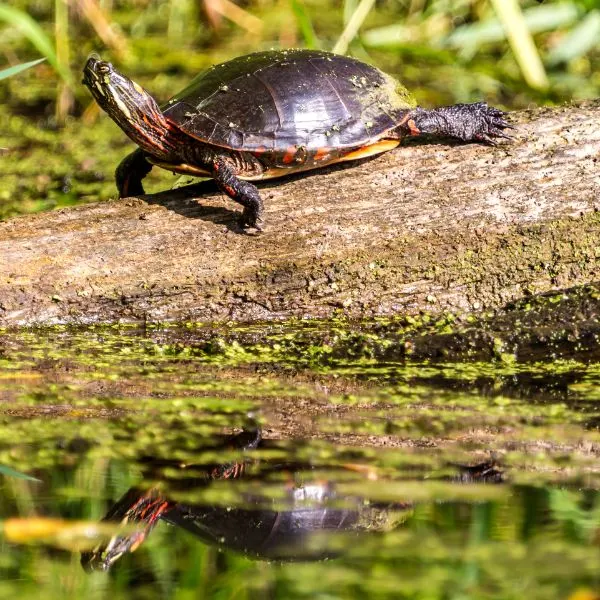
- Experience Level: Beginner
- Family: Emydidae
- Scientific Name: Chrysemys picta marginata
- Other Names: N/A
- Adult Size: Between 4 and 10 inches
- Life Span: Between 30 and 50 years
- Average price range: Between $30 and $150
- Conservation Status: Special concern
The Midland Painted turtle can often be found basking in the sun on fallen logs, large rocks, or brush piles in the water. They often bask in large groups.
When identifying this species, look for smooth olive, brown, or nearly black carapace (upper shell) and bright yellow or tan colored plastron (lower part of the shell). If you’re able to get close, you may see red and green patterns around the lower edge of the carapace.
Further identification includes yellow and sometimes orange or red stripes along the head, neck, and limbs.
Ponds, lakes, marshes, slow rivers, and other similar waterways are where you’re likely to come across this turtle. Painted turtles are found all across the nation in similar slow moving waters.
Adults consume a lot of vegetation, but they also eat crayfish, insects, fish, and other protein sources. Juveniles eat more aquatic insects and protein sources, while adults feed on more vegetation.
Pond Sliders in Ohio
2. Red Eared Slider
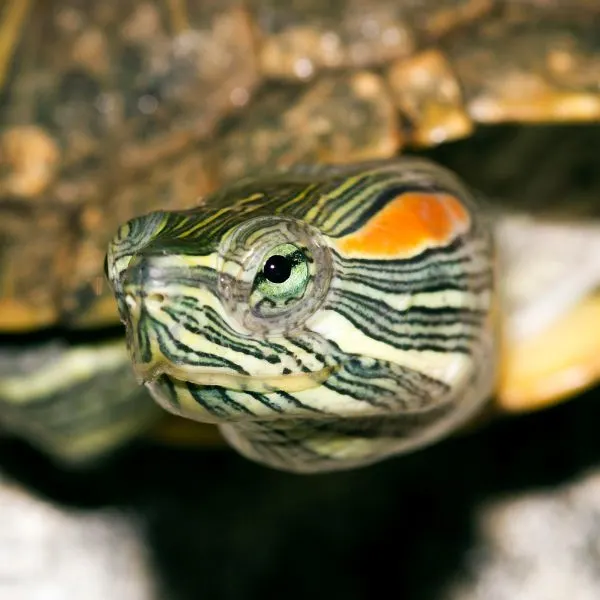
- Experience level: Beginner
- Family: Emydidae
- Scientific Name: Trachemys scripta elegans
- Common Name: Pond slider, Red-eared terrapin, Water slider
- Average Adult Size: 6 – 8 inches
- Life Span: 20 to 40 years
- Average Price Range: approximately $30 to $100
- Conservation Status: Least concern
One of the most popular pet turtle species is the Red Eared Slider. They are quite active and brightly colored. Their carapace is green to olive with orange, yellow, and darker colors all swirled around to create a beautiful shell.
These colors darken and fade as they age, especially when they bask in the sun a lot. Their plastron is pale yellow to tan with a few or many black spots on the scutes.
Their skin resembles Painted turtles with a dark background color and bright yellow stripes. What truly sets this turtle apart from Painted turtles is the set of red patches behind the eyes.
Red Eared Sliders prefer waters with slow currents such as streams, large rivers, reservoirs, lakes, oxbows, and more.
Red Eared Sliders are omnivores that feed on all types of vegetation and aquatic vertebrates and invertebrates. They will consume fish, shrimp, crayfish, worms, insects, tadpoles, leeches, and mollusks.
Spotted Turtles in Ohio
3. Spotted turtle

- Experience Level: Intermediate to Expert
- Family: Emydidae
- Scientific Name: Clemmys guttata
- Other Names: Polka-dot turtle, “Spotty”
- Adult Size: 4 to 5 inches
- Life Span: Males up to 65 years; females up to 110 years
- Average Price Range: $200 to $300
- Conservation Status: Endangered
The Spotted turtle is a small, endangered turtle found in a few northern states. They like to wade around marshes, swamps, bogs, and wetlands. Shallow waters and abundant vegetation is essential for these turtles.
They are endangered because of human encroachment, pollution—they are very vulnerable to changing water quality—habitat destruction, and poaching for the pet trade.
These turtles have slate grey to black shells with small yellow spots all over. Some may have only a few spots, while others have nearly 100. Their skin is also black with the same yellow spots and blotches all over.
Spotted turtles are omnivores that feed on vegetation such as duckweed (the Spotted turtle’s shell resembles duckweed floating on dark water) algae, and wild cranberries, as well as crayfish, spiders, millipedes, tadpoles, fish, and snails.
Sometimes they will go on land to hunt for food, but they always return to the water to consume the meal. If they catch a large worm on land, they have to submerge to eat it.
Wood Turtles in Ohio
4. Wood turtle
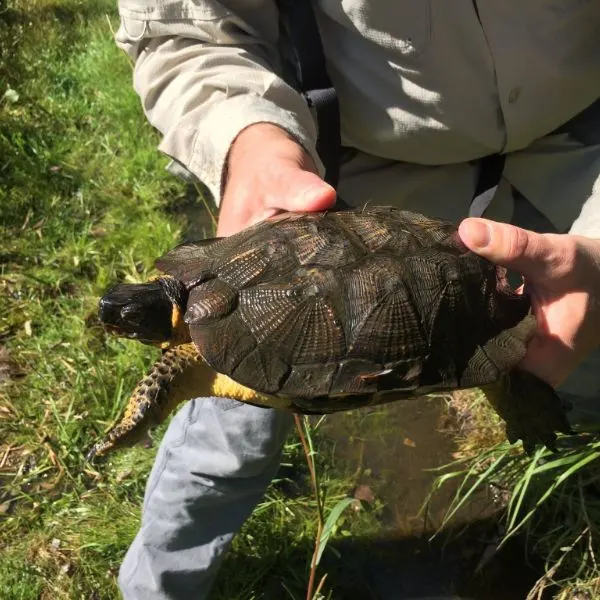
- Experience Level: Intermediate
- Family: Emydidae
- Scientific Name: Glyptemys insculpta
- Other Names: N/A
- Adult Size: 5.5 to 9 inches
- Life Span: 40 to 60 years
- Average Price Range: $250 to $500
- Conservation Status: Endangered
Wood turtles are another endangered turtle species found in Ohio, but they are only found in the northernmost counties, and still then very rarely. Ohio is right on the outer edge of their native range.
If you stumble across this turtle you’ll marvel at how it looks like it carved the shell. The carapace of the Wood turtle looks like a piece of wood. The scutes (growth plates on a turtle’s shell) are raised and ridged, looking like wood grain.
The shell is brown like polished wood, and the skin and scales are brown with patches of red or orange, especially on the inner leg area.
While these turtles are mostly terrestrial, they require a water source to survive and won’t be far from a stream, marsh, pond, or bog.
Wood turtles feed on a wide variety of foods as they are omnivores. They will eat crayfish, insects, mollusks, worms, caterpillars, and vegetation.
Box Turtles in Ohio
5. Eastern Box Turtle
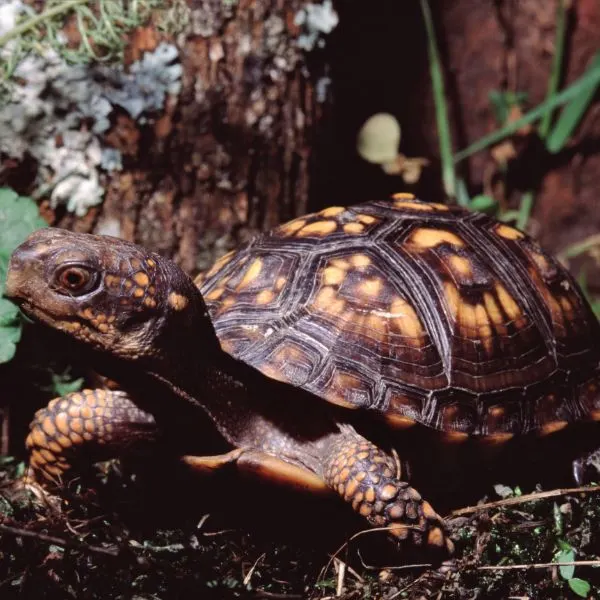
- Experience Level: Beginner
- Family: Emydidae
- Scientific Name: Terrapene carolina carolina
- Other Names: Land Turtle
- Adult Size: 4 to 7 inches
- Life Span: 50 to 100 years
- Average Price Range: $260 – $360
- Conservation Status: Michigan, New Hampshire, Massachusetts, and Connecticut—list the animal as a species of special concern, and Maine lists the turtle as endangered
The Eastern Box turtle is Ohio’s only terrestrial turtle. The Wood turtle spends a lot of time on land, but it won’t venture far from water and will completely submerge itself. Eastern Box turtles very rarely completely submerge in the water.
They prefer to stay around forests where the ground is soft and humid. When they need moisture they will bury themselves in damp leaf litter or burrow into the soft ground. Immediately following a rain shower these turtles are most active.
Eastern Box turtles have dark brown shells that are highly domed and patterned with yellow, orange, or red spots, stripes, and markings. The plastron is double hinged. This means the turtle can withdraw into the shell, and tightly close its whole body inside.
Their exposed skin and scales are dark brown with spots and patches of color the same as their shells.
Throughout their life, Eastern Box turtles won’t roam more than a few hundred yards from their original nest site.
These turtles are omnivores that eat mushrooms and fungi, plants, berries, insects, spiders, worms, caterpillars, snails, slugs, and occasionally carrion.
6. Blanding’s Turtle
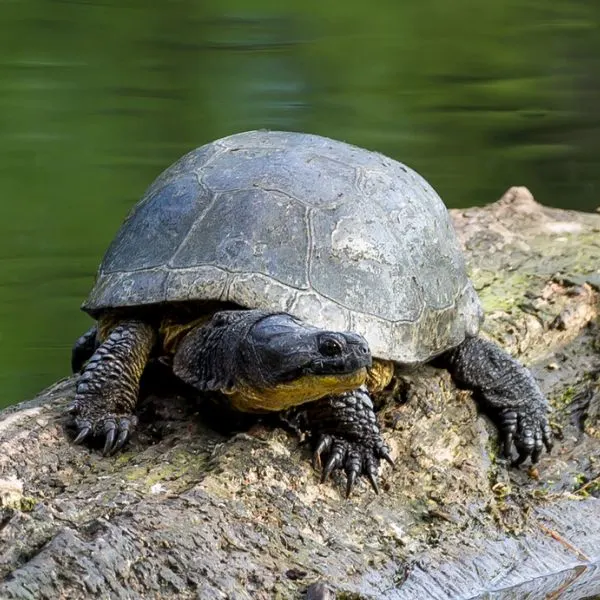
- Experience Level: Intermediate
- Family: Emydidae
- Scientific Name: Emydoidea blandingii
- Other Names: N/A
- Adult Size: 5 to 8 inches (12.5 to 20 cm)
- Life Span: Up to 80 years
- Average Price Range: $300 to $450
- Conservation Status: Endangered
Blanding’s turtle also has a hinged plastron, but the front can’t close completely like Box turtles.
The carapace on these turtles is a dark colored, high dome with a lot of faded spots. You’ll instantly recognize the Blanding’s turtle if you see it in the wild because they have a black, lightly speckled head combined with a bright yellow chin and neck.
These turtles often travel from one area of wetlands to another. They like to hang out in bogs, swamps, marshes, and other shallow waters with a lot of vegetation.
Blanding’s turtles can live 70 years or more in the wild. Scientists like to study this species because of how they don’t show signs of aging like other animals. Even in their 80s, this turtle species is able to mate and lay eggs, most other turtles aren’t able to do this.
Another omnivore on our list, the Blanding’s turtle feeds on plants, grasses, berries, nuts, crickets, insects, worms, and mollusks.
Map Turtles in Ohio
7. Northern Map Turtle

- Experience Level: Beginner
- Family: Emydidae
- Scientific Name: Graptemys geographica
- Other Name: Common map turtle
- Adult Size: Between 4 and 10 ½ inches
- Life Span: 15 to 20 years
- Average price range: Between $20 and $60
- Conservation Status: Least concern
Northern Map turtles are very skittish turtles. While they love to bask, several will always keep an eye peeled for disturbances or danger. If you want to observe these turtles in the wild, you might want to bring along a pair of powerful binoculars.
While they are often found on logs, sandbars, or along the banks of large bodies of water, Northern Map turtles will dip into the water at the slightest disturbance. If you’re able to observe them, you’ll see a dark ridge in the middle of the carapace, and a scalloped edge with serrations on the rear.
As they age and grow, these distinctions fade slightly. You’ll also see dark skin, and abundant yellowish or white stripes along the head, neck, tail, and legs.
Females grow much larger than males and can consume bigger food items. With bigger, stronger jaws the female Northern Map turtle feeds on mussels, crayfish, freshwater clams, fish, and tadpoles. Males feed more on insects and their larvae, as well as snails and other mollusks.
8. Ouachita Map Turtle

- Experience Level: Beginner
- Family: Emydidae
- Scientific Name: Graptemys ouachitensis
- Other Names: Southern Map turtle
- Adult Size: 3.5 to 10 inches (9 to 25.5 cm)
- Life Span: 15 to 20 years
- Average Price Range: $40 to $100
- Conservation Status: Least concern
The Ouachita Map turtle looks very similar to the Northern Map turtle, but the main difference is the ridge along the back. On the Ouachita Map turtle, this ridge is serrated and slightly more prominent.
If you can get close enough to observe the head, you will see white, or yellow spots on either side of the jaw, under the eyes, and an elongated patch behind the eyes.
One other difference is the plastron. The Northern Map turtle’s plastron is tan and mostly plain while the Ouachita Map turtle has a patterned plastron.
This turtle is found in the southern end of the state in large rivers and lakes. Here they are mostly carnivorous. They feed on fish, mollusks, mussels, crayfish, and small amphibians.
Snapping Turtles in Ohio
9. Common Snapping Turtle
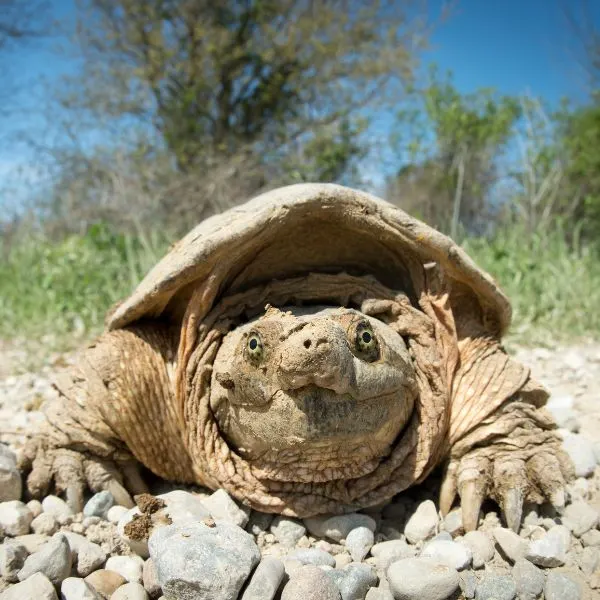
- Experience level: Intermediate to Expert
- Family: Chelydrida
- Scientific Name: Chelydra Serpentina
- Other Names: Snapping Turtle, Snapper, Eastern Snapping Turtle
- Average Adult Size: 8 to 20 inches
- Life Span: 30 – 50 years
- Average Price Range: Approximately $40 to $120
- Conservation Status: Least concern
Common Snapping turtles are the largest turtles found in Ohio. They can reach up to 20 inches, measured from end to end on the carapace, and can weigh as much as a medium sized dog.
Common Snappers have a flattened carapace with three, slight ridges near the back. It can be black, brown, or greenish in color. The green coloration comes from algae growing on the shell, as this turtle doesn’t leave the water very often.
They have large limbs, very long necks, and wide heads. Their skin color can vary from dingy yellow to dark brown. They have sharp beaks, and strong claws they will use to defend themselves, but in the water, their first line of defense is to swim away.
Rivers, ponds, lakes, swamps, and other slow moving waterways are where you’ll usually find the Common Snapping turtle. They also prefer areas with soft, sandy, or muddy substrates, and vegetation they can hide in.
Sometimes they will bask in the sun, but this is rare because as they get older, they become more lethargic and only want to hang out at the bottom of the water. Here they wait for prey to come close. Snapping turtles are omnivores, but most prefer meat to vegetation.
Common Snapping turtles will feed on fish, frogs, crayfish, small turtles, and almost anything else they can fit in their mouths. They have a bad reputation for feeding on waterfowl, but this doesn’t happen very often.
Snapping turtles don’t like to put forth a lot of effort in active hunting, so they rarely go after swift swimming birds.
Musk Turtles in Ohio
10. Eastern Musk Turtle
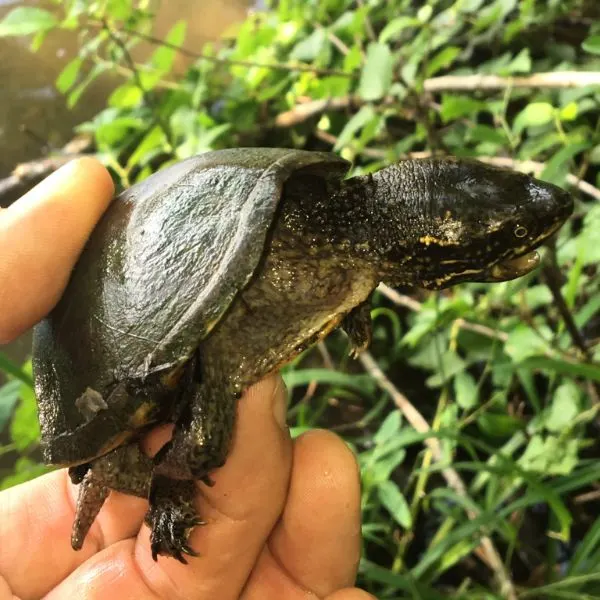
- Experience Level: Intermediate
- Family: Kinosternidae
- Scientific Name: Sternotherus odoratus
- Other Names: Common Musk turtle, Stinkpot
- Adult Size: 4 to 5 inches (10 to 12.5 cm)
- Life Span: 30 to 50 years
- Average Price Range: $30 to $120
- Conservation Status: Least concern
The Common Musk turtle is a very small turtle that is hard to spot. They are typically nocturnal and don’t bask very often. When they are on land they often bury themselves in the mud or actually climb trees.
If a tree has limbs on the ground or in the water, the Common Musk turtle will climb it in search of food. They are accomplished climbers and will ascend up to 6 feet high. Be careful of falling turtles when trolling under trees near the water’s edge.
The Common Musk turtle has a high domed, somewhat oval shaped carapace. It is grey, brown, to dark brown in color and has no distinctive colorations.
The pointed head has a pair of stripes on each side that start at the nose, and travel past the head, often to the neck. Another distinguishing characteristic is the pair of barbels on the chin and neck.
Musk turtles are also called Stinkpots. This is because they have powerful smelling glands that release a stink when they are threatened or harmed. They will also try to bite, so be careful around these little feisty turtles.
Common Musk turtles prefer shallow waters with abundant vegetation and soft, muddy bottoms. Ponds, drainage ditches, swamps, and slow streams may house this turtle.
They are nocturnal omnivores that feed on snails, small fish, tadpoles, leeches, worms, insects, spiders, and the occasional plant.
Softshell Turtles in Ohio
11. Eastern Spiny Softshell Turtle
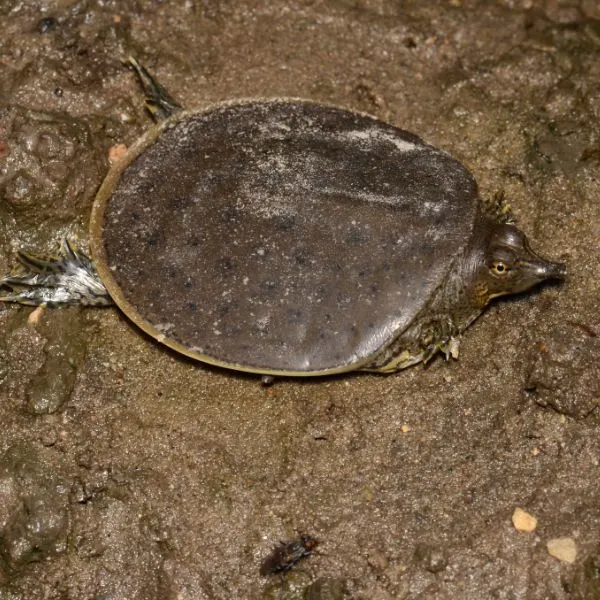
- Experience Level: Intermediate to Expert
- Family: Trionychidae
- Scientific Name: Apalone spinifera spinifera
- Other Names: N/A
- Adult Size: 5 to 9 ½ inches for males, 10 to 17 inches for females
- Life Span: Between 20 and 50 years
- Average Price Range: Between $20 and $120
- Conservation Status: Threatened in some areas
The Eastern Spiny Softshells are large, flat turtles that don’t have hard, keratinous shells. Instead, they have a rubbery or leathery shell that’s the same color as their skin. This doesn’t offer much protection from predators, but it doesn’t mean they are helpless.
Softshell turtles are excellent swimmers, and very fast on land. They also have long necks and sharp beaks that can deliver painful bites. Long, powerful claws round out the defenses of this turtle.
Don’t attempt to handle Softshell turtles unless you are trained to do so, otherwise, you might end up with scratches, cuts, and deep bites.
Females of these species grow nearly twice the size of males and have dark blotches on the carapace, but these fade over the years.
Aside from a floppy upper shell, you can recognize these turtles by the bumpy ridge along the front, the tan, sandy, or dark brown coloration on the upper side, as well as darker rings or spots, but these fade as they age.
Eastern Spiny Softshell turtles prefer clear, fast moving waters with sandy bottoms. Here they like to bury themselves and wait for food to swim by. They can stay submerged for a long time as they can stretch their long neck and snout up to the surface for air, or breathe through their skin.
Spiny Softshell turtles are mainly carnivorous. They will feed on fish, tadpoles, crayfish, mollusks, insects, and occasionally small waterfowl.
12. Midland Smooth Softshell Turtle

- Experience level: Intermediate
- Family: Trionychidae
- Scientific Name: Apalone Mutica
- Other Names: N/A
- Average Adult Size: 5 – 14 inches
- Life Span: 10 – 20 years
- Average Price Range: $50 – $150
- Conservation Status: Least Concern
The Midland Softshell turtle also has a flattened appearance, but they don’t have the fleshy bumps on the carapace. Sometimes you are able to see ribs and vertebrae under the soft carapace.
These turtles are typically olive, sandy, grey, or dark brown in coloration. Since they love to bask in the sun, older turtles are much darker than young ones.
Their underside is cream or nearly white, and their plastron is small and doesn’t offer much protection.
You’ll find these turtles in a few southwest counties in Ohio. They prefer clear running streams and rivers with sandy bottoms. Like the Spiny Softshell turtle, these turtles are mostly carnivorous and will feed on many aquatic vertebrates and invertebrates.
Wrapping up
Ohio only has a dozen types of turtles, but they all vary widely and can be seen in many different habitats. You can see large Common Snapping turtles, small Musk and Spotted turtles, and several in between.
If you’re looking for some of these species as a pet, be sure to seek out a good reptile breeder. Taking turtles from the wild as pets not only damages the local ecosystem, but wild turtles can stress very badly from such a change in environment.
Most turtles can live for decades, but when they are taken from the wild and put into captivity, their lifespan is shortened drastically. Captive bred turtles don’t experience this amount of stress and live long enjoyable lives.
If you found this list informative and enjoyed reading it, why not take a quick moment to leave a message? Tell us what you like about turtles, and maybe connect with fellow turtle enthusiasts.
Other nearby states
- Turtles in Indiana
- Turtles in Kentucky
- Turtles in Michigan
- Turtles in Pennsylvania
- Turtles in West Virginia
